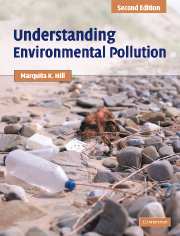Book contents
- Frontmatter
- Contents
- Preface
- Acknowledgements
- List of abbreviations and acronyms
- Chapter 1 Understanding pollution
- Chapter 2 Reducing pollution
- Chapter 3 Chemical toxicity
- Chapter 4 Chemical exposures and risk assessment
- Chapter 5 Air pollution
- Chapter 6 Acidic deposition
- Chapter 7 Global climate change
- Chapter 8 Stratospheric-ozone depletion
- Chapter 9 Water pollution
- Chapter 10 Drinking-water pollution
- Chapter 11 Solid waste
- Chapter 12 Hazardous waste
- Chapter 13 Energy
- Chapter 14 Persistent, bioaccumulative, and toxic
- Chapter 15 Metals
- Chapter 16 Pesticides
- Chapter 17 Pollution at home
- Chapter 18 Zero waste, zero emissions
- Index
- References
Chapter 16 - Pesticides
- Frontmatter
- Contents
- Preface
- Acknowledgements
- List of abbreviations and acronyms
- Chapter 1 Understanding pollution
- Chapter 2 Reducing pollution
- Chapter 3 Chemical toxicity
- Chapter 4 Chemical exposures and risk assessment
- Chapter 5 Air pollution
- Chapter 6 Acidic deposition
- Chapter 7 Global climate change
- Chapter 8 Stratospheric-ozone depletion
- Chapter 9 Water pollution
- Chapter 10 Drinking-water pollution
- Chapter 11 Solid waste
- Chapter 12 Hazardous waste
- Chapter 13 Energy
- Chapter 14 Persistent, bioaccumulative, and toxic
- Chapter 15 Metals
- Chapter 16 Pesticides
- Chapter 17 Pollution at home
- Chapter 18 Zero waste, zero emissions
- Index
- References
Summary
“Good soil is not just dirt. It is a hive of life, much of it either microscopic or even disgusting to urban eyes because urbanites don't understand the need for the growth and decay of slimy things to sustain life. Good farmers are not just people who dig in the dirt. They are the stewards of healthy soil.”
George B. Pyle, Land Institute, Salina, KansasPesticide use is among the most controversial of topics. Yet, pesticide use is prevalent. Some individuals believe pesticides are necessary to destroy the enemies of human agriculture and health. Others believe we can use organic farming to accomplish these ends without synthetic pesticides. A third group believes pesticides are needed, but recognize their limitations; they work to minimize pesticide use under the rubric of “Integrated Pest Management”. There is no simple “right” answer, but we do need answers. Consider this challenge from the authors of the article, Can green chemistry promote sustainable agriculture? “Human population is increasing. Demand for food is rising … Environmental impacts are worsening. Taken together, few issues reflect the difficulties of sustainable development more than the problem of controlling pests and increasing food production while protecting the environment and conserving natural resources.”
Section I discusses why we use pesticides and who uses them. After briefly addressing three major insecticide families, we consider selective versus broad-spectrum pesticides. Section II looks at pesticides as pollutants, as food contaminants, and their effects on non-target species. We also examine the important phenomenon of pesticide resistance.
- Type
- Chapter
- Information
- Understanding Environmental PollutionA Primer, pp. 372 - 400Publisher: Cambridge University PressPrint publication year: 2004

